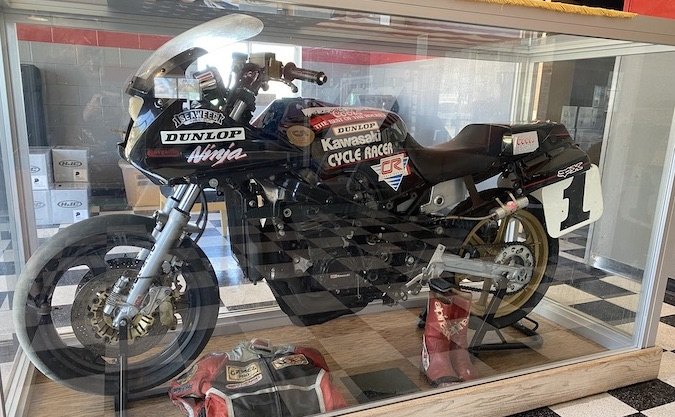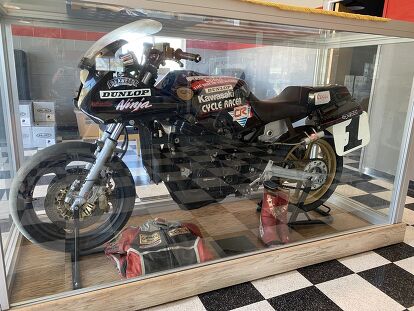MO History: The Terminator
Early Roloff will be back...
This isn’t quite Part 2 of the Earl Roloff saga, which we haven’t quite got around to yet. But it is an important digression – the story of the Kawasaki Ninja 1000 that won the first Formula USA championship in 1986, and still glowers at intruders from its glass enclosure at the Willow Springs International Raceway office. As told by Earl, Jr., himself. – John Burns
MO History: Early Roloff, Jr. Part 1
I promised a more in-depth story regarding Terminator and the 1986 F-USA Series, so here it is:
In 1986, we were focused on trying to win the first ever Formula USA Series at Willow Springs. Bill Huth, owner of the track, was the inventor of this interesting “no rules” format. Pretty much run anything you want, as long as it had two wheels. The purse money was good and if you were fortunate enough to win the Series, there was a new Toyota truck, a solid gold belt buckle, and more cash waiting at the end.
Late in 1985, my dad was trying to figure out what would be the best “weapon of choice” for the series. His decision (not mine) was the 1986 Ninja ZX1000R. His reasoning: It had about 106 rear wheel horsepower which at that time was pretty good. Agreed, but I mentioned the fact that the dry weight was about 525 pounds, and I thought the ground clearance might be an issue.
He countered with, we’ll get weight off of it and put 18-inch wheels on it, should be fine. I kinda shook my head because I realized at that point, he’d made up his mind, and just said OK let’s do it.
We stripped everything we could of off it, put the 18-inch wheels on it and took it to Willow for its maiden run in October of 1985, at an ARRA club race event. When we unloaded it, people were looking at it and asking what are you going to do with that thing? We informed them, we would be running it in the F-USA Series. Lots of interesting responses, from competitors shaking their heads, you’re kidding me right, wow, good luck, and even some laughing etc… Who could blame them? No one in their right mind would really use this for a roadrace bike except of course, my dad, and he didn’t have to ride it. Clearly, it was a one-of-a-kind race bike.
We had a local guy in San Diego weld reverse-cone megaphones to the headers for a starting point on the exhaust. The shock was still stock, as were the motor, brakes, carbs etc.. (at that time there were no exhaust systems or shocks available due to the high demand, lol!).
When we started it up, it sounded like a NASCAR. Spectators were plugging their ears, it was LOUD. Surprisingly, when I took it out for the first practice, it worked pretty good. Later that day, I won the Formula 1 class running mid minute-32’s which wasn’t bad. Most of my competitors were still shaking their heads and laughing in disbelief, but hey, it was a good start. We worked on it during the off season and by the time the opener arrive in February we had really upgraded it. The exhaust system was now a D&D four-into-one. Jim Lindemann at Fox Shocks had fabricated a one-off rear shock which worked great. We tore down the motor and my younger brother Craig did some head work, bumped the compression… Everything else was OEM, cams, pistons, rods etc. – with the exception of some 35mm Keihin flatslide carburetors.
Viola, the Terminator had arrived! The bike worked very well and had good power. Handling, while a bit slow was super stable, but ground clearance was still a bit of an issue even with the 18-in inch wheels. I’d have to have my foot on the top of the already folded peg around turn two, which was interesting to say the least. While we never had it on a scale, I’d guess the dry weight was in the 450 to 460-lbs range, which later would become the biggest issue with this bike.
During the ten-race series, it blistered the rear tire in three of the races. Jim Allen at Dunlop even flew in a special tire for the September race; it didn’t blister, but it didn’t have any grip either. In another round, the oil level window plug blew out for some unknown reason and oiled down the rear tire, which led to some wild moments.
The season was a real rollercoaster ride for us. We won the opener, were always up front, but the aforementioned problems allowed Jim Vreeke [Ken’s big brother], always fast, smooth, and consistent on his well prepared FZ750, to get a bit of a points lead going into round nine. Basically, we had to beat him just to push the series into round ten to keep our championship hopes alive.
Doug Toland [our old Cycle World pal] had been fast all year, but had some bad luck as well, with a couple of DNFs and one race where Doug Polen knocked him off the track in turn 3, with Polen going down and Toland saving it but losing a chance to win that race, which I won. I had a bird’s eye view as I was right there in third when it happened, a definite miscue by the future World Champ Polen there. (This 21-minute video is the ninth race of that 10-race 1986 series, and will definitely make you appreciate how far videography has come in 36 years.)
Jimmy V, the famous North Carolina basketball coach who died of cancer had a saying: “Don’t give up, Don’t ever give up.” If you watch this video, you’ll see why truer words have never been spoken. After a crazy, exciting and fiercely competitive season, we were backed into a corner and a must win situation to stay alive. Lucky for us, our main competitor crashed out…
The final round of the 1986 FUSA race at Willow Springs was an interesting race. I’d wrapped up the title in round 9, but obviously would be running in the finale. Upon arriving at the track people were talking about Doug Polen using alcohol. Sounded strange to me, that a guy with his incredible talents would need a shot of courage to race competitively at any event. He’d already done an amazing job zipping back and forth across the US winning Suzuki Cup Races, Interceptor and Hurricane events.
That commitment would ultimately lead him to a well-deserved Yoshimura Superbike ride, and later two World Championships with Ducati. Turns out the alcohol was not being consumed by Doug, but rather used in his 15+:1-compressioned GSX-R1100, which in F-USA was perfectly legal.
The race was fun, Chris Steward put in his best ride of the season ultimately finishing second. I rode as hard as I could for about half the race, made a couple of charges, but realized that on this day third was the best I could hope for. Doug and Chris’s new GSX-Rs were more than Terminator could deal with. Besides, I had a new Toyota pickup in the pits that I wanted to be able to drive home at the end of the day. Doug, well, he was solid early, took control of the race and that alkie-burning GSX-R was fast and as usual, its rider was too. He pulled away the last few laps for a well-deserved win, his first in the series, a great end to a very exciting season.
How the Terminator became enshrined…
The 1987 F-USA was a six-round series, which I would be defending on Terminator. Unfortunately for us, Yoshimura built this Big Papa creation that was pretty incredible, and had Scott Gray ride it. Frankly, everybody was racing for second. At the opener, Scott won and I managed to get second, James Domay third. Round 2 was interesting: As we were on the grid for the start, I realized Gray was not there, something had happened to the Yosh bike. I took advantage of that and won Round 2, which gave me a reasonable lead. Basically, the rest of the series Scott would win and I’d get second, with the exception of one round where I was third, and he won the ’87 Series.
I was just hoping he’d make a mistake or have another mechanical, giving me a shot at the title. We had worked a deal with Bill Huth and Coors for a Yamaha FZR1000, but didn’t run it until the second half of the ’87 series. I never came to grips with it and wasn’t really any faster than Terminator. The Yamaha was gone at the end of the series, so we started ’88 with Terminator again. By then, it wasn’t really competitive and our two shops in San Diego were not doing well. I rode the first, I believe, three races in ’88 and was actually second in points. But without competitive equipment, a wife and two kids, it was time to walk away and I did. No regrets: I was in one piece, it was was a great run. We won about 200 production races from 1982 thru 1987.
When we were done, Bill Huth was interested in buying Terminator because it was the winner of the inaugural series, so we sold it to him. In addition to the Toyota truck and gold belt buckle I got for that first championship, another little-known fact was they had a drawing for a – get ready for it – 1986 Ninja 1000 which Kawasaki had donated as a prize. The top 15 in the series were given a key, whichever one turned it on owned the bike. In an ironic turn of fate, Mr. Suzuki, Doug Polen, had the right key and won the bike. Frankly, we were a little disappointed that Kawasaki didn’t just give us the bike, having won the series on Terminator and all. But such is life…
Become a Motorcycle.com insider. Get the latest motorcycle news first by subscribing to our newsletter here.
More by Earl Roloff





































Comments
Join the conversation
Great story.
Great story! I haven't been out to Willow since the local racing club shut down and I wonder if Terminator is still there?